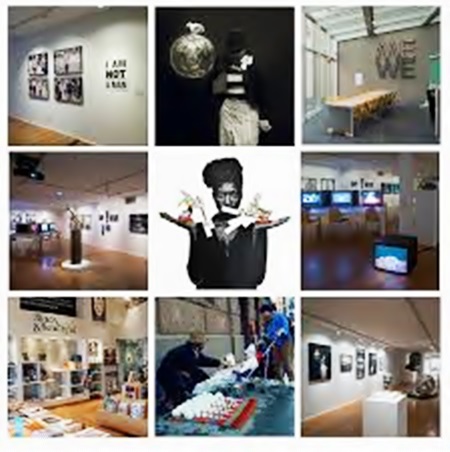Among the unexpected joys of our week in New York, beyond the inter-personal connections we formed, was our visit to the Studio Museum in Harlem—a place I had heard a great deal about, but had never visited despite the easy access from the subway. We were greeted in the lobby by the director of education who graciously gave us an overview of not only their mission and history, but also a synopsis of the current exhibitions and the artists whom we were about to enjoy.
What was immediately apparent is the community reach and impact the Studio Museum is having. <strong>The Harlem Postcard</strong> series is an example of an ongoing dialog bringing artists’ interpretations of Harlem onto accessible, free takeaways on display in the lobby. Visitors were thus offered ‘works of art’ as mementos of their visit, extending the conversation beyond the walls of the museum. The two I selected have traveled to Southern Georgia, where they now come into contact with another audience to whom I can relay my experience.
The dual purpose of the space, studio cum museum, also promotes a healthy conversation between the making of art and its appreciation by the public. In addition, the support of a minority group brings to the fore voices that have historically been under represented. Artists who are invited to work are given the opportunity to exhibit the products of their residency as a finale. The nurture of the creative process is an integral part of the mission and it can be felt throughout the building.
I was particularly struck by <strong>Radical Presence</strong><em>: Black Performance in Contemporary Art</em>. “The exhibition comprises more than 100 works by some 36 artists, including video and photo documentation of performances, performance scores and installations, interactive works, and artworks created as a result of performance actions.” (<a href=”http://www.studiomuseum.org/exhibition/radical-presence-black-performance-in-contemporary-art”>Studio Museum website</a>) The exhibition was enhanced by multiple performances punctuating its duration, reinforcing the role of museum as collaborator.
The work of David Hammons stood out. His acute interrogation of the capitalist approach to art seemed both intelligent and profound. “By assigning value and appearing to seek profit from a commonplace, short-lived object, he draws attention to both the arbitrary nature of the art market and the precarious financial conditions of many working-class New Yorkers.” (<a href=”http://www.studiomuseum.org/exhibition/radical-presence-black-performance-in-contemporary-art”>Studio Museum website</a>) Given our current socio-economic issues and the ever widening gap separating class structures, the work has an ongoing resonance and clarity.
The museum had three concurrent exhibitions offering examples of a wide range of mediums. Some of the attached images speak to this variety. Like any first experience, I left the building, and its ethos, eager to return.
LCW
